
It is difficult to have a well planted tank with a lot of sizable fish. The fish require aeration to do well and the plants do not like aeration as it depletes the water of the carbon dioxide the plants require. Plants like a CO2 level above 10 ppm. At equilibrium with the atmosphere pure water has 3 ppm CO2. Most “low tech” tanks actually are “high tech” in that they have some source of this 10 ppm. CO2. For instance the cellulose in the dirt of a Walstad or Father Fish tank. Walstad or Father Fish tanks need very careful control of the aeration to prevent dropping the CO2 level below 10 ppm.
A low tech tank WITH ONLY PLANTS, where all the CO2 came from the surface, would benefit from aeration. But there are only a very few plants which would survive at 3 ppm CO2. The really tricky part comes with fish. Fish remove O2 and add CO2. Some so called “balanced aquariums” balance the fish load and the aeration to get good plant growth. Generally the “balanced aquariums” do NOT have any aeration.
One can have a planted aquarium with a lot of decent sized fish but it is challenging. In my meanderings in the hobby over the years I have found several people who have been successful at keeping moderately stocked and heavily planted aquariums. This article outlines several of these methods.
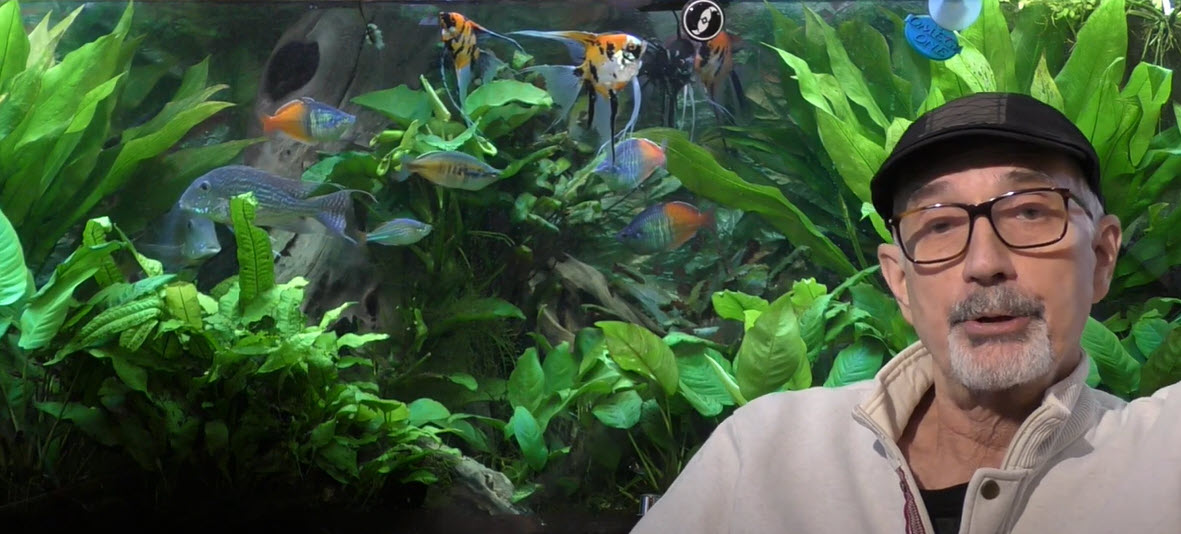
HalfMan HalfCichlid
The best heavily stocked and planted aquariums I’ve ever seen are those of John Domokos (HalfMan HalfCichlid, great YouTube channel that got my highest accuracy rating at 95%). He has several large tanks that all have a very heavy loading of fish AND a lot of very healthy plants. He is probably the only hobbyist out there that comes close to me when it comes to “over filtration”. He uses sumps and large canisters filled with foam and pot scrubbers. His water is crystal clear.
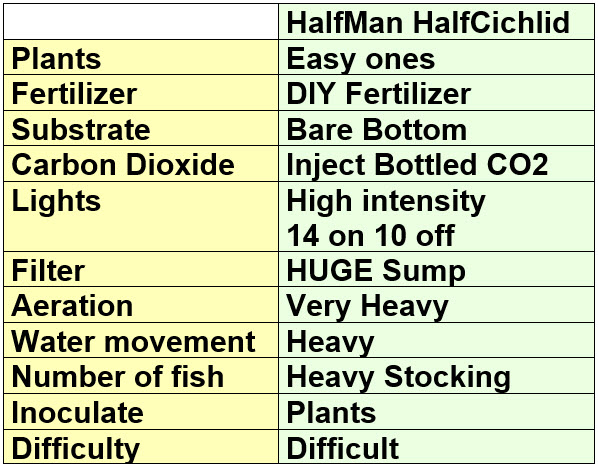
HalfMan HalfCichlid uses bladed wavemakers to create a lot of surface turbulence in his tanks and thus a lot of aeration. He also sets the wavemakers up in such a way as to allow the feces and mulm to accumulate in the bottom of the aquariums in one location. He vacuums out this mulm once a week. He does sufficient water changes to keep the nitrates at 30 ppm. The only plants he uses are the very easy Amazon Sword, Java Fern, Anubias and Buce.
HalfMan HalfCichlid doesn’t have a substrate in his aquariums. He uses pots for plants which are not epiphytes. He considers substrate a “nitrate factory”. This is probably the only area I disagree with HalfMan HalfCichlid. ANY decent filter is a nitrate factory. The main purpose of a filter is to convert one gram ammonia nitrogen to one gram nitrate nitrogen. The more this happens the better off the aquarium. More can be found about this topic at the following link:
6.7. Nitrate Factory
.

Father Fish Method
Then there is the “natural” system recommended by the popular YouTube channel “Father Fish” (great YouTube channel, even if, like all us “older” folks, he tends to ramble on a bit). The system he uses is somewhat different than most low tech planted approaches and radically different than the high tech planted approaches. He combines a Walstad soiled substrate with a deep sand bed and inoculation with detritus (dead leaves) from a pond.
The typical system he uses can be summarized as follows:
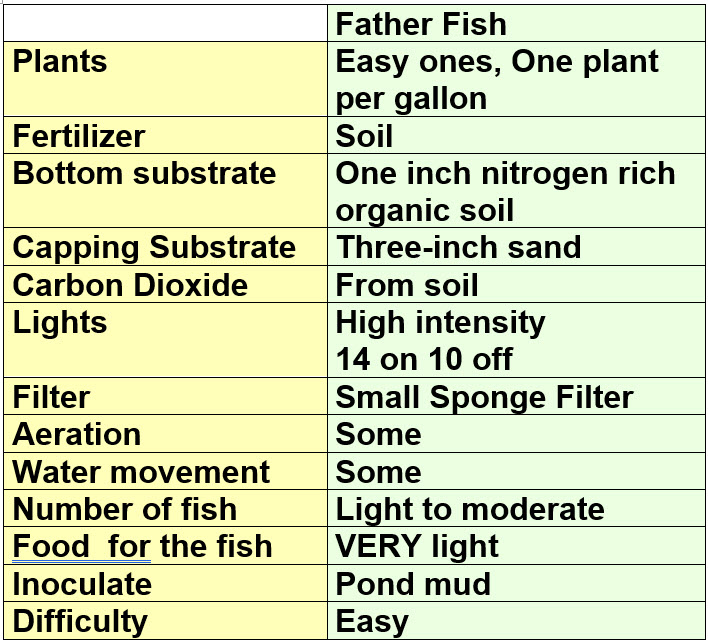
Note this is ONLY a TYPICAL set up. None of these parameters are cast in stone. They can all be changed with success.
Father Fish used an organic deep sand bed in what appeared to be about one hundred heavily planted aquariums in his store (it is now closed). Father Fish added a whole bunch of “stuff” to very organic potting soil (looks like African violet mix to me). He used one inch of this soil mix for the first inch in his deep sand bed planted low tech aquariums.
Here is one of Father Fish’s deep sand bed substrates (note the thick black layer of humus and the yellow “dull” water):
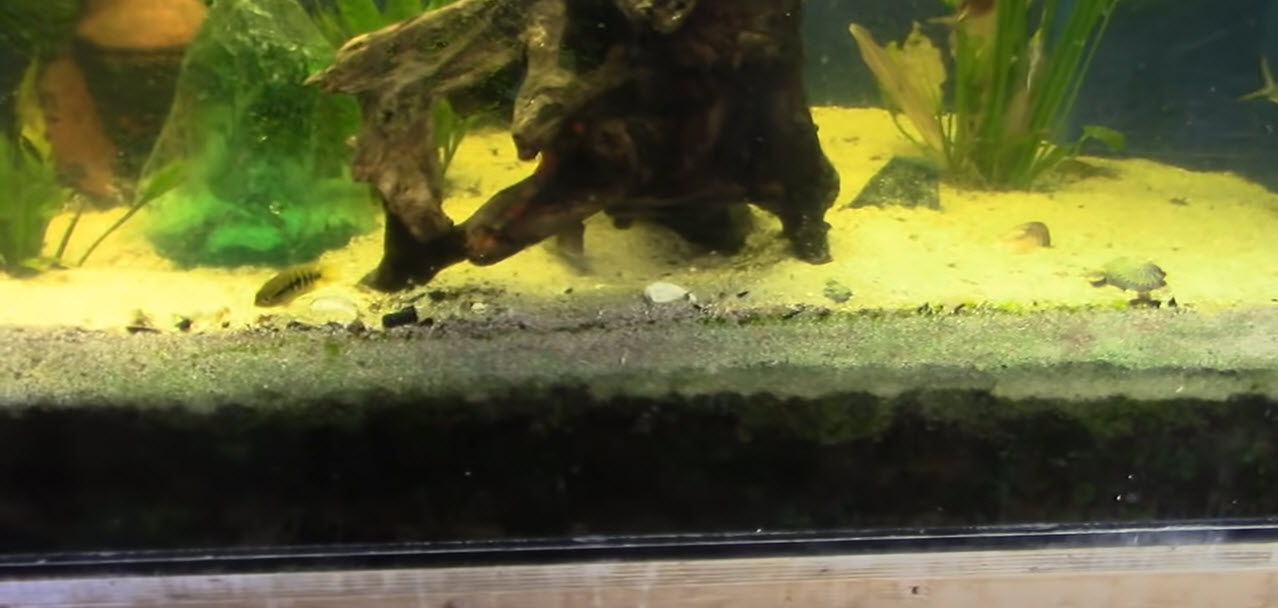
More about Father Fish’s Aquariums can be found at this link:
15.17. Father Fish Aquariums
Most of Father Fish’s aquariums had what I would term light to moderate stocking of fish. But some of his tanks have large numbers of decent sized fish in them. He uses air stones on small sponge filters for aeration. He emphasizes very light feeding of the fish.

Dan Hiteshew Aquarium
Dan Hiteshew on his site “Everyday Fishkeeping” (good YouTube channel) has some fish tanks which have some healthy plants and a moderate number of relatively large fish. He has recently been converting the 125 gallon aquarium above to a discus aquarium. He has added about ten discus to the angelfish, gouramis and rainbowfish in this planted aquarium. This is definitely “pushing the envelope” on keeping discus.
Dan Hiteshew espouses aquarium filtration by something he calls a “deep gravel filter”. It is simply a three to five inch deep bed of aquarium gravel. This gravel bed will accumulate a thick brown gunk in the spaces between the gravel stones. It can accumulate sizable amounts of nitrate in its structure as “assimilatory denitrification”. And it can foster a good growth of easy to grow “green” plants.
Dan does most of his biofiltration directly in his aquarium, largely on his plants and in detritus. This 125 does have a Sunsun 304B filter loaded with bioballs and ceramic rings on it. But Dan admits this is very poor biofiltration for this stocking of a 125 aquarium. Dan uses inoculate from ponds and thus this aquarium is very “mature”. Dan uses air stones to do aeration.
Note Dan has had some health problems in his aquarium. Dan has lost one gourami, two angelfish, one ctenopoma and one discus so I’m not too sure about the health of his aquariums. Dan initially blamed bloodworms for his problems and then blamed aggression. But “correlation does not imply causation”. I think a far more likely candidate is his admittedly poor filtration. If this is the case I suspect he will soon start to lose some more discus. Just an opinion.
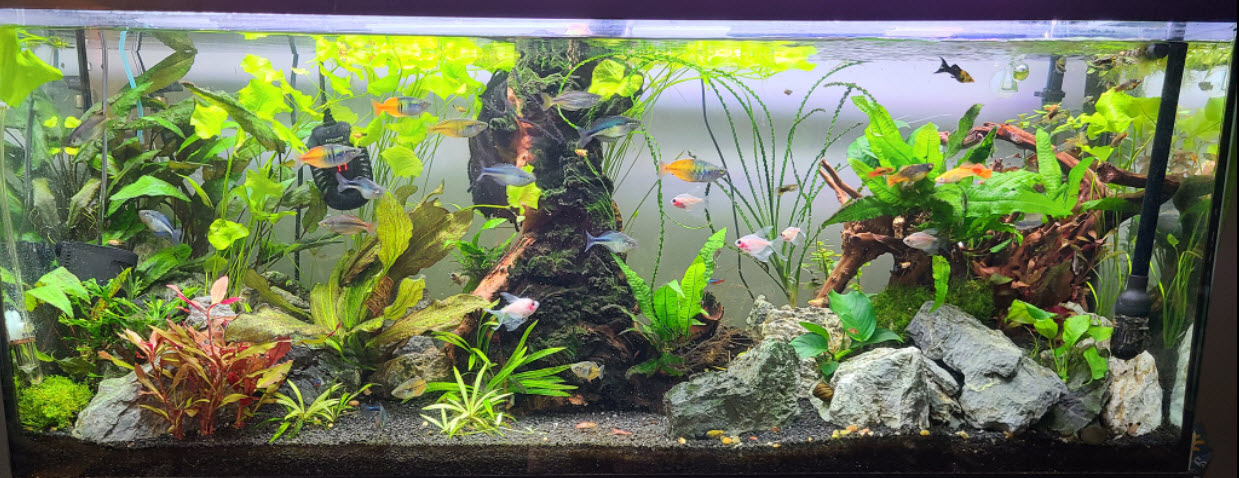
For both the Father Fish and the Dan Hiteshew methods I would add a ton of filtration to the mix. Something along the lines of a large canister filled with foam, pot scrubbers or K1. Or a sump. And I would baffle the outlet of the filter to minimize the surface agitation in the aquarium. I’m just a huge believer in over filtration in ANY and ALL tanks. Note that filtration is a NATURAL process that occurs in all ponds and streams. So an aquarium with a large filter is not “unnatural”.
The method that these heavily stocked tanks are using for adding carbon dioxide is simple. The fish metabolize the food and create a constant supply of carbon dioxide. Let us say we have two pounds of fish in a 100 gallon planted tank, i.e. decent stocking. And we are feeding this two pounds at 2% of body weight. That is about 18 grams of food per day.
Food is typically very roughly 50% carbon. So that is 9 grams of carbon and 30 grams of carbon dioxide per day. One ppm in a 100 gallon tank is roughly one third of a gram. That makes 90 ppm of carbon dioxide added per day. Figuring the carbon dioxide gases off in four hours that is still 15 ppm of CO2, plenty enough for plants to thrive. So even with some aeration a decently stocked tank can provide considerable carbon dioxide. The food will also provide considerable complete fertilizer.
Again, this all shows that there are MANY ways to be successful at keeping aquariums.
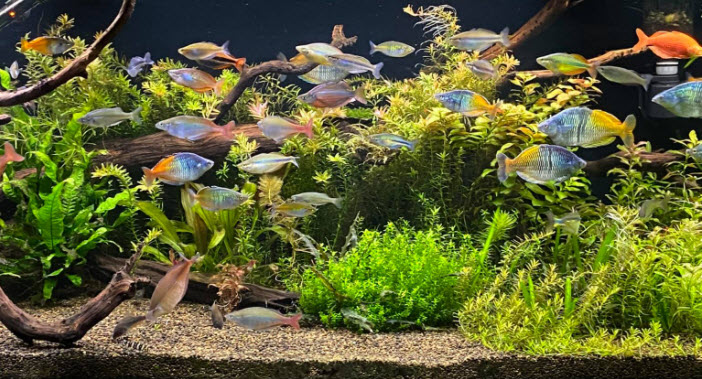
Lot of Fish with CO2 Injection
It is possible to use CO2 injection with a lot of fish. It just takes a LOT of CO2. The tank above had carbon dioxide injection to 20 ppm CO2 and lots of aeration. HalfmanHalfcichlid uses CO2 injection in his tanks.
Mike Mass of MASS Aquariums had an aquarium with lots of plants and lot of fish. He used a one-inch layer of organic soil (looked like a commercial potting soil) covered with a one-inch layer of black gravel. He had carbon dioxide pressurized injection, intense aeration, intense lighting, and significant chemical fertilization. And he only did 20% water changes every two weeks. He alternated soluble potassium and iron supplements every two days. The nitrogen and phosphate were coming from the fish food. He had a large four-gallon canister filter packed with biomedia which he only cleaned 50% of every two months.
This 75-gallon aquarium had several dozen rainbowfishes, angelfish, German blue rams, rummy nose tetras and emperor tetras. Barbs, catfish and African cichlids were noticeably absent, probably because of their tendency to stir up the gravel. Mike had some yellow labidochromis and got rid of them because they stirred up the gravel.

This is a screen capture taken from a YouTube video by MASS aquariums. I heartily recommend anyone interested to look at these videos. It has lots of plants and lots of moderately large fish. This makes it a unique aquarium. I find it very beautiful since I like aquarium fish. His water was crystal clear, probably because of “over-filtration”!
Note that the plants don’t appear to be thriving in that there is no massing that would be evidence the plant is replicating in the aquarium. So, I’m sure this wouldn’t be “very beautiful” to a connoisseur of “Amano”, or “Dutch” planted aquariums.
This aquarium was the epitome of a high-tech planted aquarium. Unfortunately, Mike tore it down as he moved. Bummer!
In the 1990’s one George Booth set up four beautiful planted tanks with a lot of fish in them, carbon dioxide injection and high light intensity. One of them, a rainbowfish aquarium, had an undergravel filter. This is a photo he took of the undergravel aquarium:
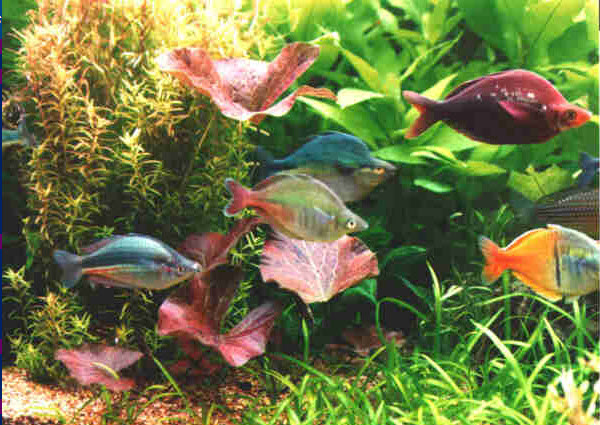
That is a very impressive planting.
Aquariums which Violate the “Rules”
As I emphasize repeatedly throughout this website, when it comes to aquariums there are no “rules”. A freshwater aquarium is Mother Nature at her finest and Mother Nature is very flexible.
I have tried many times over the years to put plants into my Lake Malawi aquariums. I have always had zero success rate. So, in the article on Lake Malawi cichlids I said plants cannot go in with African Cichlids. Then I found this aquarium on social media:

There is some vallisneria and a lot of Amazon swords (Echinodorus amazonicus and E. bleheri). This tank is a year and a half old with crushed lava rock substrate, large canister filters, lots of aeration and a pH of 7.0. The water is crystal clear. The fish have been in it the whole time and are decidedly overstocked, which I would have said was completely and totally impossible. Gorgeous and amazing! So much for my pale attempts at a planted tank with Africans.
Here is another well planted aquarium with lots of goldfish and lots of aeration. It “shouldn’t” work (goldfish love to eat plants!) but it does work:
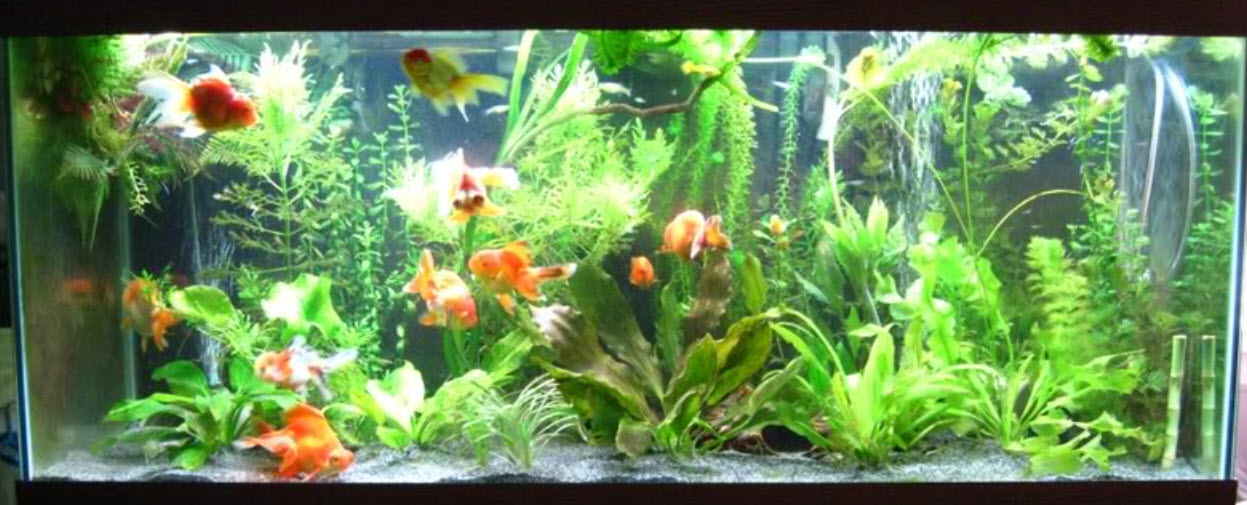
I have had several well planted discus aquariums over the years. I use undergravel filters and most plants don’t seem to like undergravel. So I planted with pots. I fill small terra cotta pots with a 50/50 sand and worm castings mix and plant the plants into those pots. I use lots of Val and some Amazon swords. I have noticed the plants over the years do grow roots out into the gravel. Some have had great success just putting plants into undergravel filters. These tanks were all well aerated with no CO2 injection and were decidedly low tech.
This all goes to show Mother Nature is VERY FLEXIBLE. If you have an idea for an aquarium GO FOR IT. The various guidelines I give for planted aquariums are only what I have found are the easiest ways to have a beautiful planted aquarium. They are not hard and fast “rules” and can be violated very successfully.
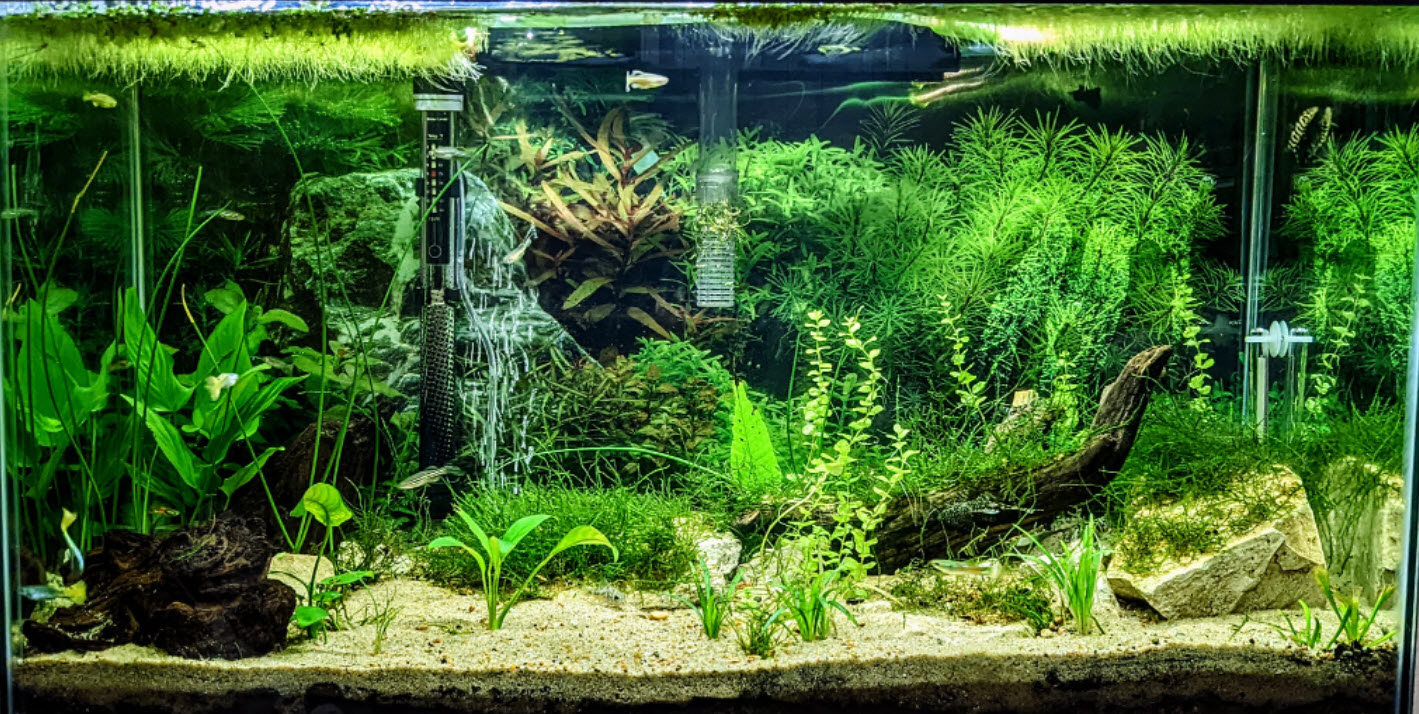
Plants for the Lots of Plants and Lots of Fish Planted Aquariums
The one constant in most of the aquariums described above is that they TYPICALLY use easy to grow plants. The plants that seem to fit this description are (* asterisks’ are VERY easy plants):
- Undemanding, rooted
- *Amazon Swordplant (Echinodorus bleheri and Echinodorus amazonicus)(dies back initially)
- *Java fern (Leptochilus pteropus, synonym Microsorum pteropus)(like open substrate or epiphytic)
- *Anubias barberi forms (likes bulbs to be above substrate or in an open substrate, very slow growing)
- Cryptocoryne (many forms, dies back when planted, then comes back)
- Bucephalandra (“Buce”, many very attractive forms, slow)
- Cabomba (can be a floater or rooted)
- Bacopa caroliniana
- Rotala rotundifolia
- Vallisneria (many varieties)
- Undemanding Carpet Plants, rooted
- Pygmy Chain Sword (Echinodorus tenellus)
- Pearlweed (Hemianthus glomeratus)
- Dwarf Baby Tears (Hemianthus callitrichoides)
- Undemanding epiphytes which like to be attached to rocks and wood
- *Java moss (Taxiphyllum barieri)
- Susswassertang (“round-leaf Pellia“), slow grower, expensive but worth it, needs to be attached.

I find the following plants to be “weedy” and unattractive but that is just my tastes. They are easy plants and many have very attractive aquariums with these plants in them:
- Fast growing plants which typically float in the upper layers of an aquarium
- Elodea (Anacharis), Egeria and Hydrilla are very similar appearing floating plants
- Riccia sp.
- Milfoil (Myriophyllum sp.)(note this plant smells bad!)
- Water Sprite (can be emergent)
- Water Wisteria (Hygrophila difformis, very similar to water sprite)
- Hornwort (Ceratophyllum demersum)
- Undemanding emergent plants (“floaters”, they float on the surface of the aquarium water with the leaves exposed to the air)
- Water Lettuce (Pistia stratiotes)
- Duckweed (grows so fast some consider it a noxious weed)
- Salvinia
- Azolla
- Amazon Frogbit (Limnobium laevigatum)

Low Tech CO2 System for Aquariums
There is a low cost, low tech system which adds considerable CO2 to an aquarium. The details of this system can be found at this link:
15.6.1 Low Tech CO2 Aquarium System
.
Planted Aquariums in Depth
The following sections will give you some general guidelines on the easiest ways to set up a beautiful planted aquarium:
15. Planted Aquariums
15.1. Planted Aquariums in Depth
15.2. Fish for Planted Tank
15.3. Fish Limitations
15.4. Types of Planted Aquariums
15.5. Fertilizing
15.6. Carbon Dioxide
15.7. Substrates for Planted Aquariums
15.8. Walstad Aquarium
15.9. High-Tech Planted Aquarium
15.10. Hybrid Planted Aquariums
15.12. Hau Planted Aquarium
.
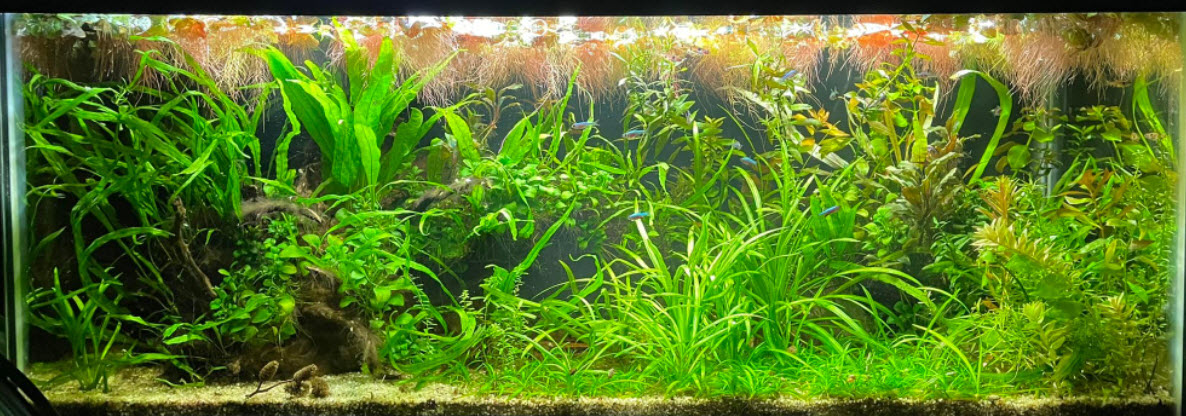
.
Return to Home Page and Main Menu
.
Aquarium Science Website
The chapters shown below or on the right side in maroon lead to close to 400 articles on all aspects of keeping a freshwater aquarium. These articles have NO links to profit making sites and are thus unbiased in their recommendations, unlike all the for-profit sites you will find with Google. Bookmark and browse!
.

Dmitri says
There is also an old Russian YoTuber called “Крутой Аквариумист” (“Cool aquariumist”), claiming to be into the hobby since childhood, who advocates for heavily planted tanks with a possibility of high stocking with livebearers. The idea is that the livebearers fertilise the plants with their feces and breathing, while the plants supply those fish with oxygen. Light gets turned on in the morning and turned off in the evening. Feeding may be light, because livebearers can feed off algae and microorganisms. Since livebearers reproduce quickly, their population stabilises at a level sustainable by the tank. But his videos are all in Russian.
DG says
Hello! I am curious if you have any exposure or experience with tub ponds or summer tubbing. I am entering the fish hobbyist realm completely backwards – I built a glorified tub-pond/water-feature/bird-bath in my backyard (six small-medium interconnected preformed pond pools with a waterfall and recirculating pump), then added plants, then added fish, then started putting together indoor fish tanks for when I’ll have to bring the fish inside for the winter. (The pools are too shallow for the fish to survive a New England winter.) So my indoor fish tanks will also overwinter my non-hardy pond plants – rotala, bacopa, pennywort, frogbit, hornwort, plus a few that I put out in the ponds just to acclimate for the tanks (pogostemon, vallisneria, creeping jenny). I take reasonable care of the ponds, but I also let Mother Nature do her thing and it’s very much survival of the fittest out there – so I expect the indoor tanks will be more like a pampered vacation home for the fish. I am surprised to read through this section and find that my plants may not actually do well. I definitely won’t have any CO2 injection. I see a few of them listed in the Undemanding Plants list. Any thoughts on using pond plants as “easy” undemanding plants for indoor aquariums? Most of mine are bare-roots tossed into shallow-ish water with minimal substrate in the ponds (maybe a little aquatic soil, pea gravel, or 2-inch stones to hold them roughly in place), and the bacopa and pennywort are both thriving to the point of taking over – I use both of them as natural dams to prevent the fish from escaping “downriver” into the other pools. (The guppies especially enjoy skipping across two pools and going down the waterfall.) It seems like there’s a missed opportunity here for more traditional aquarists – or, more likely, my pond plants are going to do worse than I expect in the indoor tanks.
Thanks for all your hard work and your amazingly detailed and research-based information!
Olga says
Hello, great website!
One brief comment: Father Fish uses 2 inch sand as capping substrate (not 3 as stated above).
Greetings!
Dave says
In reply to Larne … Plants like a CO2 level above 10 ppm. At equilibrium with the atmosphere pure water has 3 ppm CO2. Most “low tech” tanks actually are “high tech” in that they have some source of this CO2. For instance the cellulose in the dirt of a Walstad tank. But you are correct in that a low tech tank WITH ONLY PLANTS, where all the CO2 came from the surface, would benefit from aeration. But there are only a very few plants which would survive at 3 ppm CO2. And Walstad tanks (and Father Fish) replenish their CO2 levels at night so they shouldn’t be aerated. The really tricky part comes with fish. Fish remove O2 and add CO2. Some so called “balanced aquariums” balance the fish load and the aeration to get good plant growth. Generally the balanced aquariums do NOT have any aeration.
Larne says
Quote: “The fish require aeration to do well and the plants do not like aeration as it depletes the water of the carbon dioxide the plants require.”
a) What about a low-tech tank were all the CO2 comes from the surface; wouldn’t surface agitation increase CO2 as well as O2?
b) What about at night when plants aren’t using CO2?
Dave says
In reply to Ranjan …. Father fish is only one of several hundred “ways” to keep good aquariums. And I do not like the water in Father Fish’s tank either. Too much debris and too much tannic acid. You sound more like you are keeping a halfman halfcichlid tank. But even then you’re not using CO2 or fertilizers and you don’t seem to have much in the way of filtration. It all goes to show how flexible Mother Nature can be.
Ranjan says
Hi, I’ve been watching recently Father fish videos and also read his posts on discord. But one thing that I really didn’t like is the color of the water and underfeeding . I’ve been keeping fishes from childhood and recently started again. I’ve a 3’×2’×3′ tank and it’s really really overstocked. I’ve no soil in it, all I have is 1-3 cm stones with no sharp edges. I’ve lot’s of plants but all planted in terracotta pot or ceramic tea cups with very tiny stones as substrate ( less than 2 mm ) . I never change 100% water, I change 70% once a month and add water to replenish due to evaporation. I’ve only sponge filters with airstones , but I’ve small lava rocks in a container set above the filters so that bubbles pass through the rocks and have amazing swords among the lava rocks. I’ve 1 gold severum ( 6″ ), 11 angelfish, 2 badis badis, 4 pearl gourami , 4 dwarf gourami, 4 yoyo loaches, 5 female guppy, 5 zebra danios, 1 electric blue ram . They’re with me since 2021 and even angelfishes laid eggs. Idk whether the dwarf or pearl gourami is now making bubble nest. No CO2, no fertilizer added , only dechlorinator. I only feed live food 4 times a day ( only enough that they finish in 1 minute ). My water is crystal clear . So I’ve been pretty much successful till now. I’m not fully convinced with father fish method.
Thank You